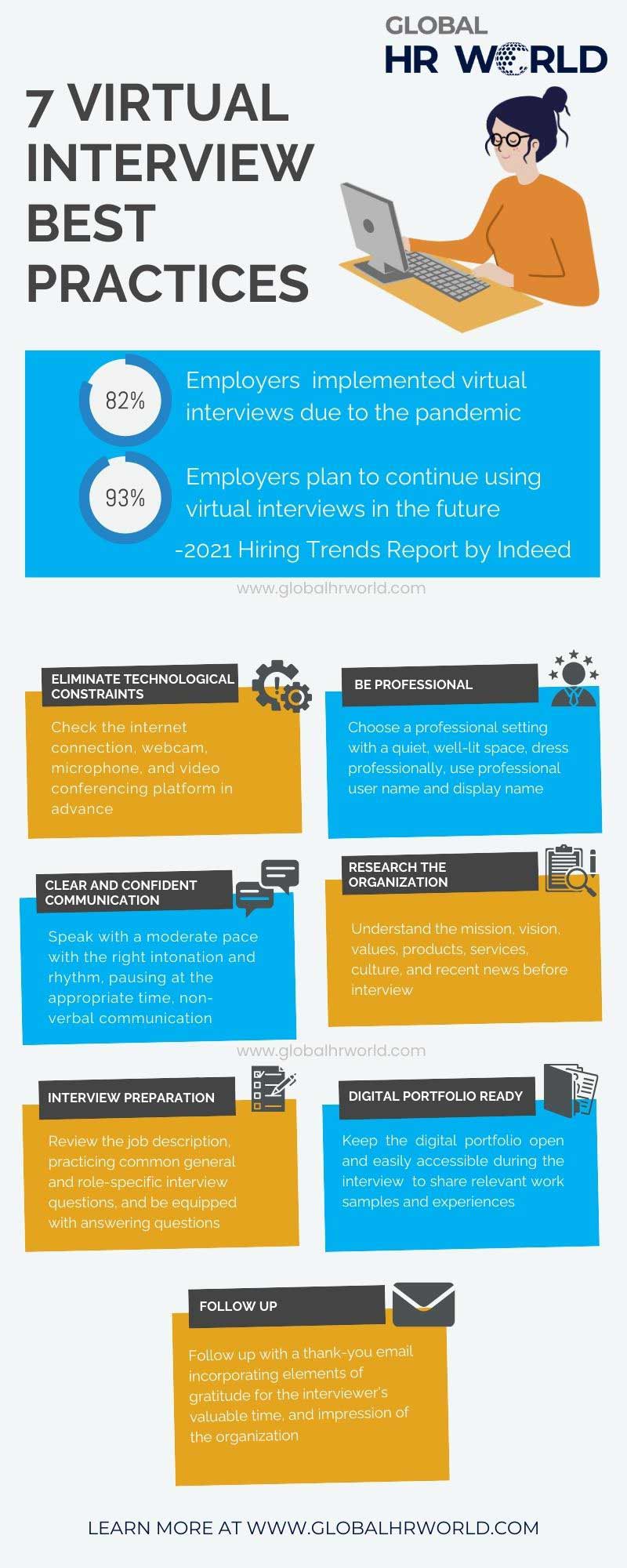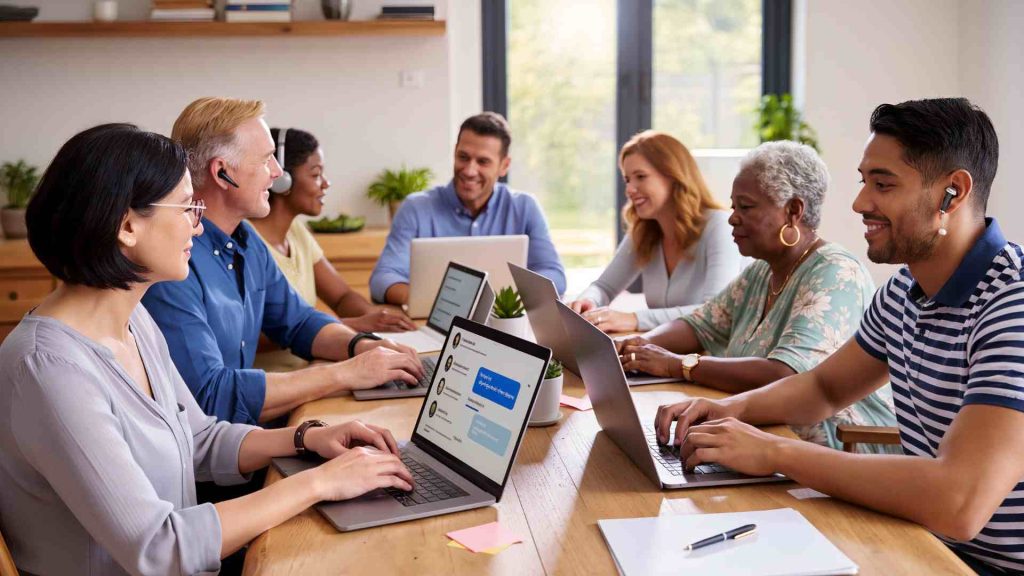Virtual interviews have become integral to today’s recruitment process, assessing candidates’ abilities and integrating them into the organization. However, to ensure a seamless hiring experience, every recruiter and candidate must follow certain virtual interview best practices benefitting both employer and the candidates. This article provides insights into the 7 virtual interview best practices for job-seekers along with explaining the benefits of virtual interviews over traditional in-person interviews.
Understanding Virtual Interview
A virtual interview is a job interview conducted virtually utilizing technology incorporating elements like video conferencing, phone calls, and other AI-powered platforms. According to the 2021 Hiring Trends Report by Indeed, “82% of respondents say they implemented virtual interviews due to the pandemic and 93% of employers plan to continue using virtual interviews in the future.” Although popularized with the inefficiency of conducting face-to-face interviews during the pandemic, virtual interviews are largely preferred by individuals. Virtual interviews can be real-time (synchronous) or pre-recorded questions (asynchronous) enabling the candidates and interviewer to connect from different physical locations.
Benefits of Virtual Interviews
According to Cronofy Candidate Expectations Report 2023, “72% of applicants say interview efficiency affects job acceptance.” A job interview is the most crucial step in the hiring process offering employers and candidates an opportunity to evaluate each other. Employees benefit from showcasing their skills while clarifying their job expectations with interviews.

Cost and Time Efficiency
Virtual interviews benefit both employers and candidates in terms of cost and time efficiency by reducing the expenses of travel, food, and accommodation, as well as enabling quicker scheduling of the interviews. In this manner, virtual interviews streamline the recruitment process and promote better resource allocation offering convenience to all parties involved.
Elevated Talent Pool
As virtual interviews eliminate geographical barriers, employers could reach top-quality candidates worldwide. Apart from benefitting remote roles, passive job seekers who are unwilling to travel as there are no major commitments. Moreover, candidates with mobility challenges or disabilities are encouraged to attend the interview without anxiety, promoting inclusivity.
Flexible Scheduling
Organizations offering virtual interviews can schedule them irrespective of time constraints, enabling recruiters and candidates to attend the interview smoothly. The hiring process moves faster as interviews can be scheduled quickly disregarding travel concerns.
Recording and Review
Virtual interviews offer consistency to the hiring process by enabling the recording of the entire process. This practice eliminates bias in recruiting by ensuring fair and consistent evaluations and revisiting the candidate’s response before arriving at a final decision on applicant hiring.
Employer Branding
Organizations that promote virtual interviews are perceived as employers of choice by candidates. When companies promote a standardized virtual interview, it strengthens the organization’s reputation through fairness in selection. The process by removing geographical constraints promotes an inclusive and diverse workforce.
7 Virtual Interview Best Practices for Candidates
As virtual interviews are largely preferred by employers and candidates alike, following certain best practices is crucial. Appearing in a virtual job interview is not limited to answering the questions being asked, it involves a professional presence and showcasing your best. Here are seven virtual interview best practices for candidates.
Virtual Interview Best Practices #1: Eliminate Technological Constraints
Before attending the interview, remove all technological constraints in advance by thoroughly checking the internet connection, webcam, microphone, and video conferencing platform in advance. Moreover, to eliminate physical noises hindering the interviewing process, use headphones with a built-in microphone. To minimize distractions, close unnecessary tabs and turn off other notifications before logging in for the interview. Even though the technological constraints are eliminated, always be prepared with a backup plan such as an additional internet source for smooth conversing.
Virtual Interview Best Practices #2: Be Professional
When attending a virtual interview, be professional by choosing a professional setting with a quiet, well-lit space is necessary. Additionally, dress professionally as if for an in-person face-to-face interview, avoiding bright colors that may not be displayed well on the camera. Ensure that the user name and display name are professional and join 5 to 10 minutes before the start of the interview.
Virtual Interview Best Practices #3: Clear and Confident Communication
Communicating with clarity and confidence is essential for creating the best impression to the interviewer. This includes speaking with a moderate pace with the right intonation and rhythm and pausing at the appropriate time to demonstrate your enthusiasm. In addition, maintain non-verbal communication by promoting eye contact, moderate hand gestures, smiling, and nodding. For conveying a professional look and effective communication, position the camera at eye level.
Virtual Interview Best Practices #4: Research the Organization
Understanding the mission, vision, values, products, services, culture, and recent news about the company provides a significant advantage during the interview. It prepares the applicant to understand the nature of work at the organization and creates the impression in the recruiter that the candidate is genuinely interested in joining the company. Researching the organization can be performed by visiting the company website, social media pages, and job platforms like Glassdoor and Ambitionbox to know the culture.
Virtual Interview Best Practices #5: Interview Preparation
An essential practice that can be followed for grabbing your dream job is preparing for the interview. Effective preparation reduces stress, gives confidence, maximizes performance, and demonstrates professionalism. Interview preparation can be done by reviewing the job description, practicing common general and role-specific interview questions, and being equipped with answering questions like salary expectations and when the applicant can join the organization.
Virtual Interview Best Practices #6: Digital Portfolio Ready
A portfolio is a visual representation of a person’s skills, capabilities, and expertise, making them stand out from the rest. Creating a well-structured and organized portfolio and storing it on cloud platforms for easy access is a good practice. During the interview process, keeping the digital portfolio open and easily accessible during the interview allows the candidate to share relevant work samples and experiences effectively.
Virtual Interview Best Practices #7: Follow-up
After the virtual interview, following up with a thank-you email is a good practice. Following this practice demonstrates your willingness to join the organization and the role. A follow-up email should incorporate elements of gratitude for the interviewer’s valuable time, impression of the organization, and enthusiasm for joining the company. It is crucial to send the email promptly within 24 hours of the interview to ensure the message is fresh and on time.
Conclusion
To sum up, virtual interviews involving elements like video conferencing, phone calls, and other AI-powered platforms are largely preferred by employers and candidates for the immense benefits they offer. The advantages include cost and time savings by avoiding travel and accommodation, an elevated talent pool attracted to the organization, flexible scheduling of the interview, recording and reviewing the interview process, and employer branding. To ensure that you are easily hired by an organization, it is essential to follow seven virtual interview best practices.
They are eliminating technological constraints, being professional, ensuring clear and confident communication, researching the organization before the interview, preparing for the virtual interview, keeping the digital portfolio readily available, and following up to demonstrate your interest in joining the organization. It is suggested that job seekers should follow the virtual interview best practices to land their dream profession and role.
Infographic

Knowledge Check!
Frequently Asked Questions (FAQs)
What are virtual interview best practices?
To ensure that you are easily hired by an organization, it is essential to follow seven virtual interview best practices. They are eliminating technological constraints, being professional, ensuring clear and confident communication, researching the organization before the interview, preparing for the virtual interview, keeping the digital portfolio readily available, and following up to demonstrate your interest in joining the organization.
What are the benefits of virtual interviews?
The advantages of virtual interviews include cost and time savings by avoiding travel and accommodation, an elevated talent pool attracted to the organization, flexible scheduling of the interview, recording and reviewing the interview process, and employer branding



